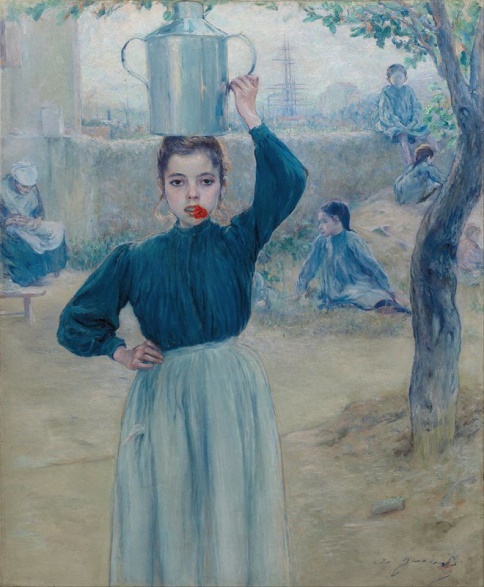
The painting addressed in this visual analysis paper is the work created by Spanish artist Adolfo Guiard Larrauri The Little Village Girl with Red Carnation, 1903. It is an oil on canvas portrait painted in the style of impressionism. At first sight, the artwork might seem to display an ordinary girl holding a jug and a carnation. However, the implied symbolic meaning is more complicated given the style of the work. Thus, Guiard uses color selection, smudged brush strokes, and positioning of figures in The Little Village Girl with Red Carnation to emphasize the opposition between the children who play freely and the main working character.
The positioning of figures in the painting is symbolic and influential in terms of the artist’s intention. The children positioned in the background to the right are playing on the ground while an older woman is working on the left side of the background. On the contrary, the village girl in the painting is at the center and forefront of the canvas, which directly forces the audience to concentrate on this character. Moreover, the girl’s outfit and facial expression do not match her age, which might be attributed to her necessity to work instead of play. Such a combination of positioning and appearance portraying implies the artist’s intention to emphasize the intersection of childhood and adulthood in the central character. Indeed, since the girl is portrayed in the middle between an older woman representing adulthood and children representing youth, her figure conveys the transition between ages. Her necessity to work and become an adult early implies her underprivileged status, which is shown through the girl’s clothing and a jar she is holding. The audience sees her dressed similarly to an old woman and working as an adult.
The selection of colors that the painter uses allows for attracting viewers’ attention to the carnation and the girl’s face. The predominantly pale and pastel background in cold blue tones is characteristic of the impressionist style. These colors contrast with the bright warm red color of the carnation at the forefront of the painting. The girl is holding the flower between her teeth. As a bright section of color on the central figure’s face, the eyes of the viewers are inherently attracted to it. The gaze is directed at the girl’s youthful face with sad eyes looking directly at the audience. Such a choice of colors is symbolic in terms of transmitting the inner longing for beauty and freedom that the girl expresses with the flower.
In addition, the technique of brush strokes allows the artist to blur the background and highlight the accuracy of the central figure’s image. Indeed, the background figures are painted with free, almost careless smudged brush strokes, which provide the image with a sense of less importance. Similarly, the central figure’s clothing is painted in harsh strokes; however, the girl’s face is depicted with precise and accurate strokes that allow for detailed observation of her facial expression of sadness. Moreover, the carnation is painted in a bold stroke, similar to a mere spot of paint. Nonetheless, the color contributes a strong connotation to the flower despite non-precise drawing.
Conclusively, the oil on canvas portrait by Adolfo Guiard Larrauri, The Little Village Girl with Red Carnation, is a vivid example of impressionism and its use of symbolic features. The artist has incorporated the principles of deliberate positioning of figures on the canvas, the choice of colors, and brush strokes to emphasize the girl’s transition from childhood to adulthood. Thus, the visual representation of the poor village girl at work implies an in-depth symbolic meaning delivered through artistic techniques.
Work Cited
Guiard, Adolfo Larrauri. The Little Village Girl with Red Carnation, 1903. The Bilbao Fine Arts Museum, Bilbao. Google Arts & Culture.